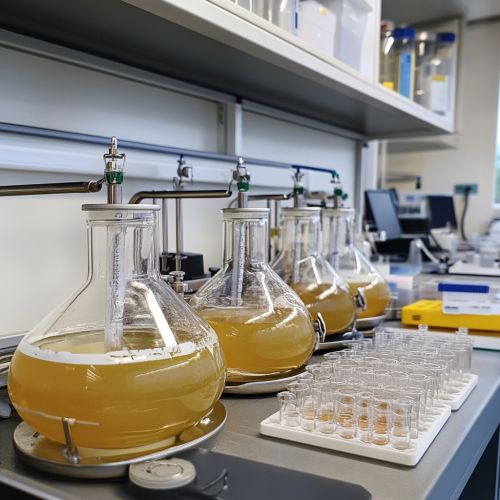Volatile Fatty Acids
Introduction
Volatile fatty acids (VFAs) are a group of short-chain fatty acids that are characterized by their low molecular weight and high volatility. These compounds are primarily produced through the anaerobic fermentation of carbohydrates by microorganisms in various environments, including the gastrointestinal tract of animals, soil, and aquatic ecosystems. VFAs play a crucial role in numerous biological processes and industrial applications, making them a subject of significant interest in fields such as microbiology, biochemistry, and environmental science.
Chemical Structure and Properties
Volatile fatty acids are typically composed of carbon chains ranging from two to six carbon atoms. The most common VFAs include acetic acid, propionic acid, butyric acid, valeric acid, and caproic acid. Each of these acids has distinct chemical properties that influence their behavior in biological and environmental systems.
Acetic acid, with the chemical formula CH₃COOH, is the simplest and most abundant VFA. It is a colorless liquid with a pungent odor and is miscible with water. Propionic acid (C₂H₅COOH) and butyric acid (C₃H₇COOH) are also colorless liquids, but they have slightly higher boiling points and distinct odors. Valeric acid (C₄H₉COOH) and caproic acid (C₅H₁₁COOH) are less volatile and have higher molecular weights compared to the shorter-chain VFAs.
The volatility of these acids is a key characteristic that influences their role in various processes. Their ability to evaporate easily allows them to be transported through air and water, impacting both local and global environments.
Biological Production and Metabolism
Microbial Fermentation
VFAs are primarily produced through the anaerobic digestion of organic matter by microorganisms. This process occurs in environments such as the rumen of ruminant animals, the large intestine of monogastric animals, and anaerobic digesters used for waste treatment. During fermentation, complex carbohydrates are broken down into simpler sugars, which are then converted into VFAs by a diverse community of bacteria and archaea.
In the rumen, for example, cellulose and other plant polysaccharides are hydrolyzed by cellulolytic bacteria into glucose and other monosaccharides. These sugars are then fermented by a variety of bacteria, including species of the genera Bacteroides, Clostridium, and Ruminococcus, to produce VFAs, carbon dioxide, and hydrogen.
Role in Animal Nutrition
VFAs serve as a major energy source for ruminant animals, such as cattle and sheep. In the rumen, VFAs are absorbed through the ruminal epithelium into the bloodstream, where they are transported to the liver and other tissues. Acetic acid is primarily used for fatty acid synthesis, propionic acid is converted into glucose via gluconeogenesis, and butyric acid is metabolized into ketone bodies.
In monogastric animals, such as humans and pigs, VFAs are produced in the large intestine through the fermentation of dietary fiber. Although they contribute less to the overall energy supply compared to ruminants, VFAs still play a significant role in colonic health and metabolism.
Environmental Impact
Soil and Aquatic Ecosystems
VFAs are important intermediates in the carbon cycle of soil and aquatic ecosystems. In soil, VFAs are produced by the microbial decomposition of organic matter and serve as substrates for methanogenesis and denitrification. These processes are crucial for the recycling of carbon and nitrogen, influencing soil fertility and greenhouse gas emissions.
In aquatic environments, VFAs can be produced in sediments and water columns through the anaerobic degradation of organic matter. They can also be introduced through agricultural runoff and wastewater discharge. The presence of VFAs in water bodies can affect the biochemical oxygen demand and lead to the proliferation of anaerobic conditions, impacting aquatic life and water quality.
Industrial Applications
VFAs are utilized in various industrial applications due to their chemical properties and biological origins. They are used as precursors for the synthesis of chemicals such as esters, alcohols, and polymers. Acetic acid, for example, is a key raw material in the production of polyvinyl acetate and cellulose acetate.
In the field of renewable energy, VFAs are being explored as potential substrates for the production of biofuels. The conversion of VFAs into biogas through anaerobic digestion is a promising technology for waste treatment and energy recovery. Additionally, VFAs can be used as feedstocks for the production of bioplastics and other biodegradable materials.


Analytical Techniques
The analysis of VFAs in biological and environmental samples is essential for understanding their role and impact. Several analytical techniques are commonly used for the quantification and characterization of VFAs, including gas chromatography (GC), high-performance liquid chromatography (HPLC), and mass spectrometry (MS).
Gas chromatography is the most widely used method for VFA analysis due to its high sensitivity and resolution. Samples are typically derivatized to improve volatility and detectability before being injected into the GC system. The separation of VFAs is achieved using a capillary column, and detection is often performed using flame ionization detection (FID) or mass spectrometry.
High-performance liquid chromatography is another technique used for VFA analysis, particularly when dealing with aqueous samples. HPLC offers the advantage of not requiring derivatization, making it suitable for the analysis of VFAs in complex matrices such as wastewater and fermentation broths.
Mass spectrometry, often coupled with GC or HPLC, provides detailed structural information about VFAs and their derivatives. This technique is particularly useful for identifying unknown VFAs and studying their metabolic pathways.
Health and Safety Considerations
While VFAs are naturally occurring compounds, their production and accumulation can pose health and safety risks. In industrial settings, the handling and storage of VFAs require careful consideration due to their corrosive nature and potential for volatilization. Proper ventilation and protective equipment are necessary to prevent exposure to VFA vapors, which can cause respiratory irritation and other health effects.
In agricultural and waste management contexts, the production of VFAs can lead to odor issues and contribute to the formation of greenhouse gases such as methane and nitrous oxide. Mitigation strategies, such as optimizing anaerobic digestion processes and implementing odor control measures, are essential for minimizing the environmental impact of VFAs.
